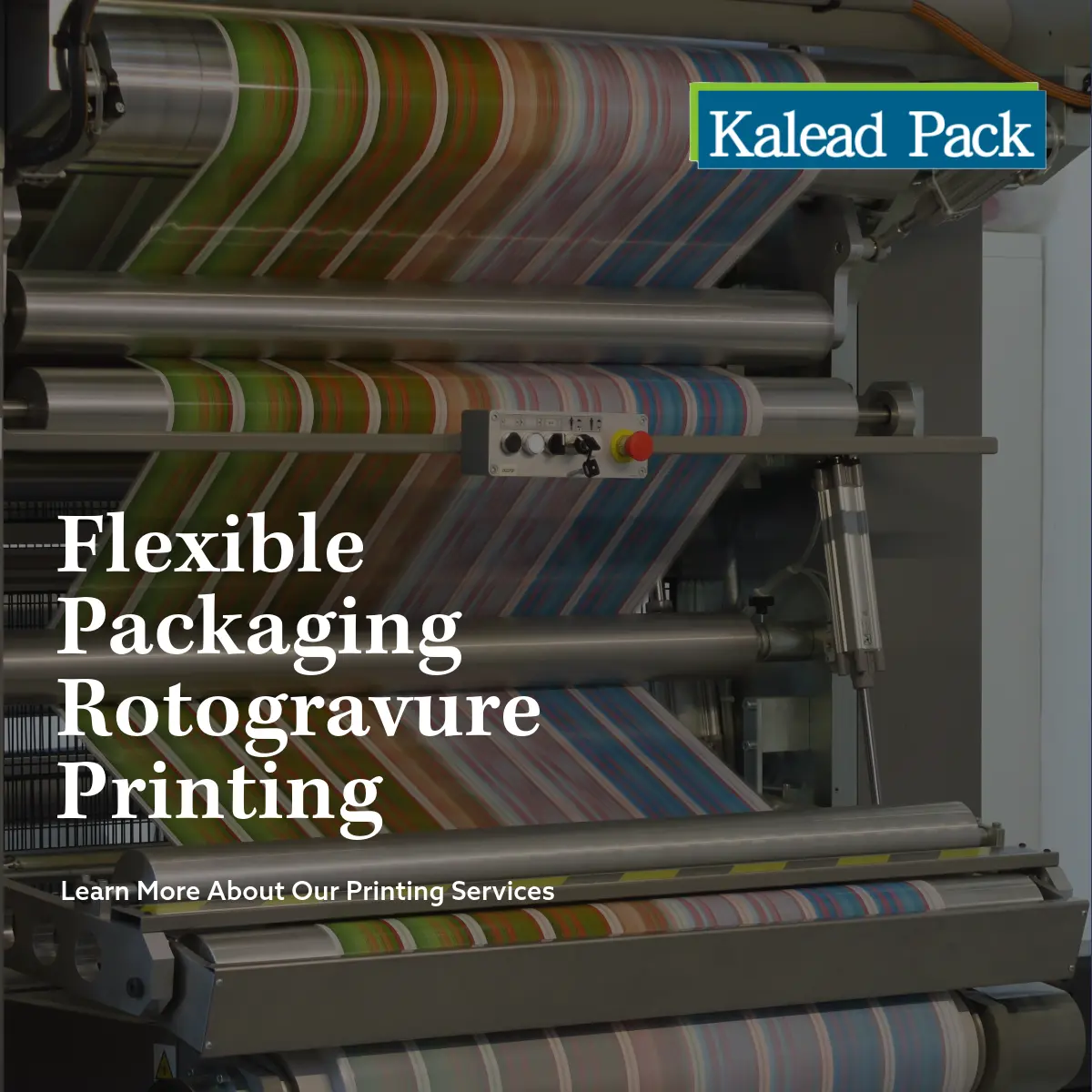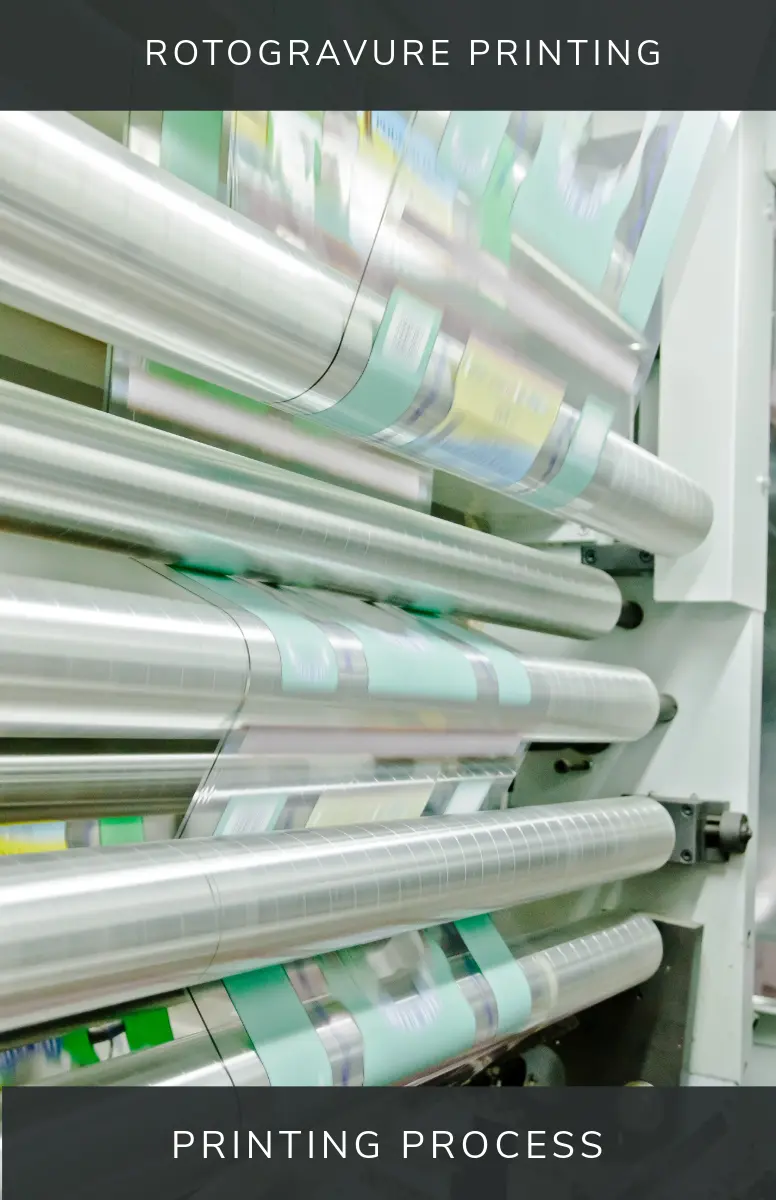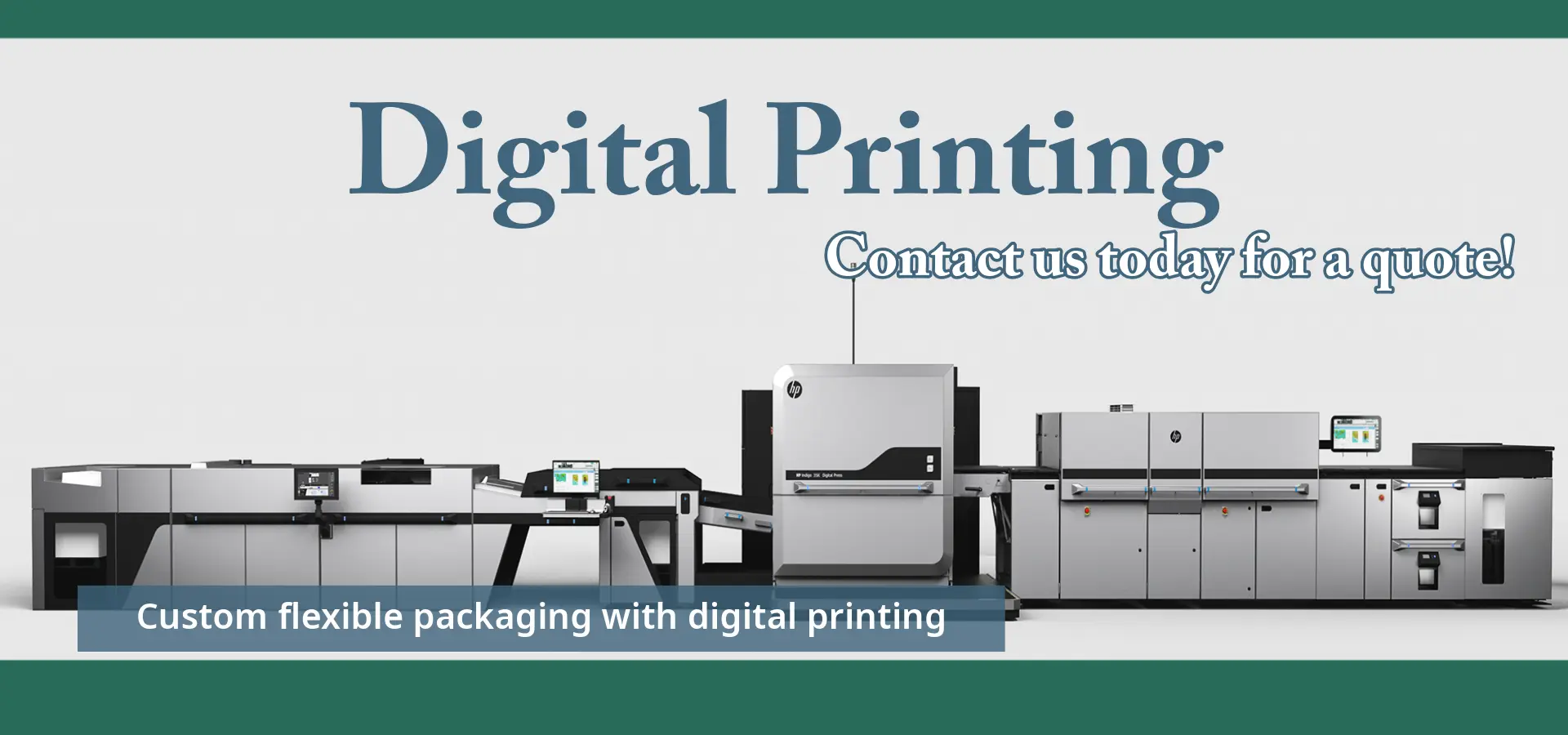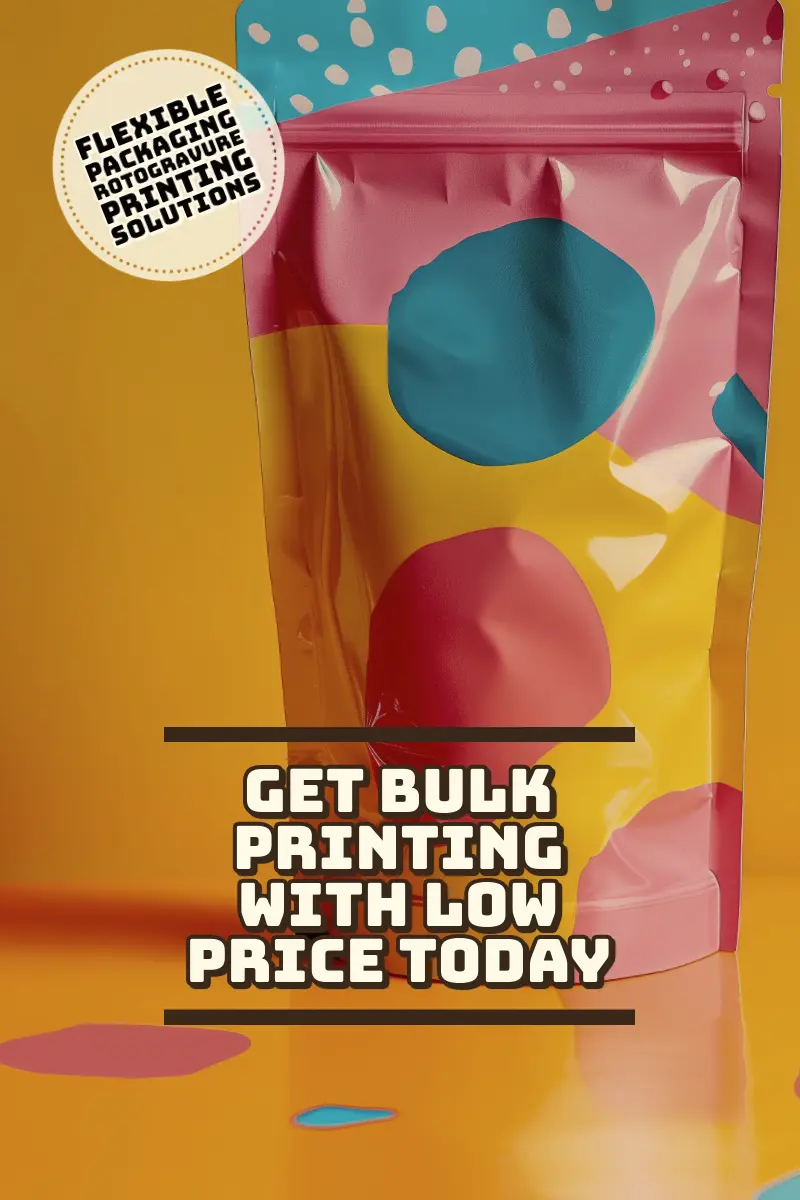Rotatiedruk
Flexible packaging rotogravure printing remains the top choice for large-scale custom packaging. This well-established traditional printing technology provides high-quality image reproduction, making it ideal for various flexible packaging materials.
What Is Flexible Packaging Rotogravure Printing?
Flexible packaging rotogravure printing is an effective method to print images and text on plastic, foil, and paper. This process involves engraving the image onto a cylinder, which transfers the ink onto the packaging material. The cylinder contains tiny cells that hold the ink, and it transfers the ink to the material as it rotates.
One of the main benefits of rotogravure printing is its ability to produce high-quality, vivid images on packaging surface. This is perfect for packaging that needs to be eye-catching and detailed, like food, medicine, and other consumer products.
(Many food or non-food manufacturers use this printing method to make detailed designs on bulk packaging bags.)
The process starts with engraving the cylinder with the desired image, using either a laser or a diamond tool. The operator then mounts the cylinder onto the printing press, where it picks up ink from an ink fountain. A doctor blade removes excess ink, leaving the ink in the engraved cells. As the material passes through the press, it contacts the inked cylinder, transferring the image onto the material.
Rotogravure printing is efficient and fast, making it a cost-effective choice for large-scale production. It offers excellent color consistency and uses various inks and materials, making it suitable for different packaging needs.


Rotogravure Printing Process
1. Cylinder Engraving
The rotogravure printing process begins with cylinder engraving. A copper-plated steel cylinder gets engraved with tiny cells. Each cell holds ink.
2. Ink Application
Subsequently, the cylinder spins within an ink reservoir.. The cells fill with ink. A doctor blade scrapes off excess ink from the surface. Only the cells contain ink.
3. Printing
The cylinder then contacts the substrate, which could be paper or plastic film. The ink transfers from the cells to the substrate. This step ensures precise and consistent prints.
4. Drying Process
After printing, the material passes through drying ovens. These ovens evaporate solvents from the ink. This step is crucial to prevent smudging.
5. Material Rewinding
Finally, the printed material gets rewound onto a roll. This makes it ready for further processing or packaging. Rewinding ensures that the print remains intact.
6. Slitting
The slitting process begins with mounting the printed roll material onto the slitting machine. The machine uses rotary blades or laser cutting technology to cut the wide roll into strips of the desired width.
Advantages of Rotogravure Printing
High-Quality Image
Rotogravure printing offers excellent image quality. The process can produce highly detailed images with sharp lines and vivid colors. This makes it ideal for packaging that needs to stand out on shelves. Colors remain consistent across large print runs.
Flexible Substrate Printing
Rotogravure prints on multiple substrates. It works well with thin films, aluminum foil, and paper. This flexibility allows businesses to choose the best material for their products. For example, snack packaging often uses thin film for their durability and lightweight properties.
Cost-Effectiveness
Rotogravure is efficient for long-run printing jobs. The initial cost of creating engraved cylinders is high.
However, these cylinders last a long time without degrading. This leads to lower costs for large volume orders. Companies save money when producing millions of identical packages.
Cost Benefits
Rotogravure has significant cost benefits. Although setup costs are high, per-unit costs decrease with larger quantities. This makes it a cost-effective choice for products requiring mass production. Brands benefit from lower overall expenses while maintaining high-quality prints.
Rotogravure Printing for Large Production Runs
- Rotogravure printing may be an excellent option for brands looking to reduce per unit costs, especially for production runs of 10,000 units or more.
- It is a more durable and fade resistant printing method than digitaal drukken.
- Pantone-kleurmatching is mogelijk voor nauwkeurige kleuren.
- Het biedt een ruime keuze aan zakafwerkingen en effecten.
- De kleurconsistentie is uitstekend tussen verschillende drukruns.
- Koperen drukplaten worden gebruikt, één voor elke kleur, en kunnen worden hergebruikt voor miljoenen afdrukken over meerdere runs.
- Plaatkosten zijn eenmalige kosten en besparen vaak al na de eerste run.
- Individuele platen kunnen worden vervangen om ontwerpen bij te werken met wijzigingen in formule-informatie.
Diepdruk vs. Digitaal Drukken
Flexibele verpakkingsdruk kent 2 veelvoorkomende drukmethoden. Hier is een samenvatting:
Diepdruk:
- Het beste voor grootschalige, hoogwaardige en consistente drukprojecten.
- Ideaal voor industrieën die gedetailleerde en levendige verpakkingen nodig hebben, zoals voedsel en farmacie.
Digitaal Drukken:
- Het beste voor kleine tot middelgrote drukruns en maatwerkprojecten.
- Ideaal voor bedrijven die snelle leveringen en gepersonaliseerde prints nodig hebben, zoals marketingmaterialen en custom verpakkingen.

Vergelijking van Digitaal en Diepdrukken
| Kenmerk | Rotatiedruk | Digitaal Drukken |
|---|---|---|
| Technologie | Gebruikt gegraveerde cilinders | Gebruikt digitale bestanden en inkjet/laser |
| Opstarttijd | Lange opstarttijd | Korte opstarttijd |
| Kostenefficiëntie | Kosteneffectief voor grote volumes | Kosteneffectief voor korte runs |
| Druk kwaliteit | Hoogwaardige, consistente prints | Hoogwaardig, maar kan variëren |
| Kleurbereik | Uitstekende kleurweergave | Goed kleurbereik |
| Levertijd | Langer vanwege opstart en productie | Snelle levering |
| Flexibiliteit | Minder flexibel, geschikt voor herhalende taken | Zeer flexibel, eenvoudig ontwerpen aan te passen |
| Initiële kosten | Hoge initiële kosten door cilindergravering | Lage initiële kosten |
| Variabele gegevensdruk | Niet geschikt | Ideaal voor variabele gegevensdruk |
| Milieu-impact | Meer afval en chemicaliëngebruik | Minder afval, milieuvriendelijker |
| Duurzaamheid van prints | Zeer duurzaam en lang houdbaar (tot 3 jaar) | Duurzaam, maar kan vervagen |
Veelgestelde Vragen
Het diepdrukproces gebruikt gegraveerde cilinders om inkt op een substraat over te brengen. De cilinder draait in een inktbak, neemt inkt op in de gegraveerde cellen en brengt deze over op het materiaal.
Diepdruk biedt hoogwaardige en precieze afbeeldingen, efficiëntie en snelheid. Ook kosteneffectief voor grote drukruns vanwege duurzaamheid en snelle productie.
Ja, diepdruk is kosteneffectief voor grote volumesDe opstart kan aanvankelijk duur zijn, maar bespaart op de lange termijn voor grootschalige productie.
Ja, KaleadPack biedt gratis monsters aan en ondersteunt wereldwijde verzending. Neem gerust contact met ons op. Wij bieden een totaaloplossing voor verpakkingen, inclusief zakken, foliedruk en verpakkingsmachines.

